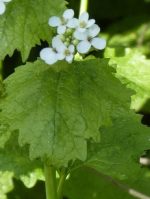 Garlic mustard is a biennial weed in the mustard family, Brassicaceae, that also includes broccoli, radishes, and alyssum. It is native to Europe, western and central Asia, andnorthwestern Africa but was introduced to North America by the settlers who used it in cooking as a flavoring. Garlic mustard naturalized and is now found growing in poor, dry soil and shady areas in waste areas, woodland edges, and roadsides in most of the Northeast and Midwest.
Garlic mustard is a biennial weed in the mustard family, Brassicaceae, that also includes broccoli, radishes, and alyssum. It is native to Europe, western and central Asia, andnorthwestern Africa but was introduced to North America by the settlers who used it in cooking as a flavoring. Garlic mustard naturalized and is now found growing in poor, dry soil and shady areas in waste areas, woodland edges, and roadsides in most of the Northeast and Midwest.
Description: A thin white taproot gives rise to a rosette of green leaves in the first year. In the second year the rosette produces an unbranched stem 1-3′ tall bearing triangular or heart-shaped leaves 4-6″ long with coarsely toothed margins. From mid-spring to early summer terminal clusters of four-petaled flowers appear and give way to short, four-sided seedpods that stand upright on the plant and contain two rows of small shiny black seeds. A single plant produces many seeds that are the main means of reproduction for the plant.
Control: Pull or hoe seedlings when they appear in the fall or cover the soil with a dense mulch. Pull, dig, cut, or mow older plants before they set seed, checking every week or so to make sure no new shoots have appeared. In extreme cases an herbicide with glyphosate is effective. when applied in early spring or late fall when temperatures are above 35 F.